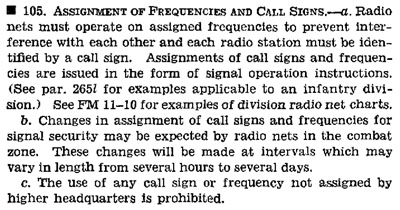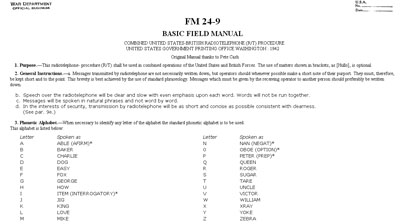Tableau Number 2
The SCR300 Radioman
Date: April 2013
Author: Pat Costa - 88th ID & 5th Rangers Dog Company
90th IDPG Editors - Chris Guska, Lee Mudd, Mike Ellis
Training:
Operators for the SCR-300 at the company level would be furnished by the company receiving the radios; training was the responsibility of the Division Signal Officer and was to be accomplished via communications schools established within the division. (FM 7-24 Communications in the Infantry Division, Pg. 4).
Soldiers would have had an introduction to the technology during stateside training.
Codenames & Call Signs:
Codenames and call signs for the net would be managed and administered by the Net Control Station (NCS) meaning the most senior unit in the net that has a radio .
(FM 24-5, Signal Communication, Oct 1942. Pg. 117)
The assignment of radio net call signs and unit codenames would be done by the Division Signal Officer.
Changes in the codes would be sent via circulars and messages (FM 24-5, Signal Communication, Oct 1942. Pg. 117)
Making the Call:
Sending and receiving of radio messages was rather simple. In sending a radio-telephone call during combat, a soldier would dial to the right frequency, use the thumb switch on the handset, speak and await response. When units used radios they had to utilize the radio net call sign with unit codenames
After establishing contact with the proper net and unit, the soldier would be expected to communicate in a natural voice.
When talking, the idea was to keep the conversation short and simple to prevent the enemy from identifying who you are and possibility getting a “fix” on the transmission position via triangulation.
In this manner, Saving Private Ryan does an excellent job of illustrating a proper radio-net transaction. At the end of the opening landing scene, actor Tom Hanks picks up a SCR-536 and a short conversation between “Sugar-Cane” and “Sugar-Charlie” takes place. “Sugar” is the radio net call sign and “Charlie” and “Cane” are the unit radio code-names.
Radio call signs and unit codenames can be anything. Radio call signs for the net and unit codenames can use words like “BOSTON” or they can use words and numbers like “BATO 6”. However, radio manuals suggest that the radio call signs and unit codenames should have some type of relationship. For example: the radio call sign is “NEW YORK”, the unit codenames could be “BRONX,”“BROOKLYN,” “QUEENS,” “MANHATTAN,” and “STATEN ISLAND.”
Radio Call Procedure:
Hardscrabble Farm has a transcription of FM 24-9 with the complete Radio Call Procedure for viewing online. This is the "Need to Know" essentials of being a Radioman.
- Phonetic Alphabet
- Pronunciation
- Callsigns
- Components of a message
- Critical Procedures
Comments on Call Procedure:
Chad Phillips, amateur Signal Corps Historian explains-
“[On] an active net you may have several people talking, that’s why the call signs are used in every sentence in order to keep sense of who is talking to who” (2010, Personal e-mail correspondence).
At a reenactment more than one radio may be using the same frequency (channel number on a Family Radio Service [FRS] radio).
Additionally, in terminating the call Chad states that,
“[I]t is the initiating caller’s job to sign off. [S]ince he is the one who has the stuff to say. No one else knows when he is finished. I could have 30 "breaks" in there, and if you cut me off, you won’t get to know what I have to say” (2010. Personal e-mail correspondence).
SCR-300 Modifications:
In Combat Lessons 9, 1944. Pg. 37 a soldier is reported taking down his antenna and replacing it with a wire that was put into the antenna socket and attached to the strap on the soldiers helmet. For reenacting, one could get some field phone wire secure it inside the antenna socket and then secure the wire to the helmet either by friction tape, wrapping it around a helmet bail or some other method.
Enemy Jamming:
The enemy would often try to jam the radio. The Germans would attempt to "jam" transmissions with white-noise or annoying sounds on the same frequency. One veteran describe how, "...occasionally they [Germans] would figure out what channel we were one. They played scales on an organ for hours on end, which almost drove [the person listening] crazy he had to stay with his ear glued to the receiver.
Adkins, Andrew Jr. and Andrew Adkins III. 2005. You Can't get Much Closer Than This: Combat with Company H, 317th Infantry Regiment, 80th Division. Casemate, Havertown, PA. Pg. 133.
Introduction
Section 1: By the book - TO&E
Section 2: Notes from the manuals on equipment
Section 3: Original Photographs - Key Observations
Section 4: Notes on Training and Use (you are here)
Section 5: Putting it together- Modern Interpretation
Section 6: Adapting the SCR300 for Reenactment Use
90th IDPG Original Research






